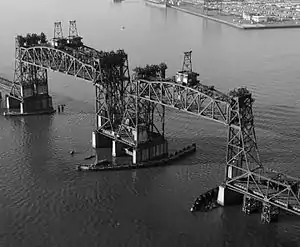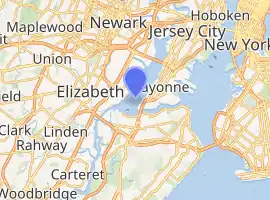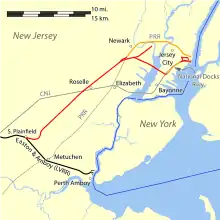CRRNJ Newark Bay Bridge
The Newark Bay Bridge of the Central Railroad of New Jersey (CNJ) was a four-track railroad bridge that had four main lift spans. It opened in 1926, replacing an outdated two track bascule span built in 1901, that in turn had replaced a wooden draw bridge that originally opened on 29 July 1864. The bridge served the main line of the CNJ, carrying daily interstate trains as well as commuter trains.[2][3][4] The bridge connected Elizabethport and Bayonne at the southern end of Newark Bay. The designer of this bridge was J. A. L. Waddell.
Newark Bay | |
|---|---|
 The Central Railroad of New Jersey Newark Bay Bridge with its lifts raised (one of which had already been destroyed by collision); it was demolished in the 1980s | |
| Coordinates | 40°39′16″N 74°09′00″W |
| Carries | Central Railroad of New Jersey |
| Crosses | Newark Bay |
| Locale | New Jersey |
| Official name | Newark Bay |
| Characteristics | |
| Design | Vertical lift bridge, through Parker truss[1] |
| Total length | 2 miles (3.2 km) |
| Width | 4 tracks |
| Longest span | 299 feet (91 m)[1] |
| Clearance above | 135 feet (41 m)[1] |
| History | |
| Designer | John Alexander Low Waddell |
| Opened | 1926 |
| Closed | 1980-1988 |
| Location | |

| |
History
The lift spans were a pair of two-track spans over two separate shipping channels; the longer span being 299 feet (91 m) long, while the shorter span was 210.75 feet (64.24 m), giving a navigable width of 216 feet (66 m) and 134 feet (41 m) respectively. Vertical clearance was 135 feet (41 m) open and 35 feet (11 m) closed.[5][6] Each span was capable of independent movement, as well as any combination of tandem movements. Bridge movement, interlocking, and signals were controlled from a large manned structure on the operational midpoint between the east and west drawspans and above the tracks.[5]
Despite the operational flexibility and safeguards built into the bridge, increase in marine traffic and ship size only made the bridge a greater maritime hazard. At the same time, however, decline in rail traffic did not make it any less of a hazard to the railroad. On 15 September 1958, a commuter train plunged off the south span which had been opened for marine traffic, killing 48 people, including former New York Yankees second baseman Snuffy Stirnweiss.[7][8][9] On 19 May 1966, the French freighter S.S. Washington collided with the northeast lift span, rendering two tracks unusable.[10][11] Despite an eventual 2nd Circuit judgment in CNJ's favor the span was never repaired as the two affected tracks were deemed redundant by the railroad due to the sharp decline in rail traffic and the momentous change in the railroad's operations which occurred less than a year after the accident.[12]
After the Aldene Plan went into effect in May 1967 the only passenger service on the bridge was the Bayonne-Cranford shuttle, known as the "Scoot".[11] The last freight train crossed the bridge in 1976 prior to the formation of Conrail; the last passenger train left Bayonne's Eighth Street Station on 6 August 1978.[11] Despite Bayonne's efforts to save the bridge, demolition of the central lift spans began in July 1980 after the United States Coast Guard declared the structure a navigational hazard to ships.[13] The trestle and approaches were removed in 1987-1988 when it became apparent that a replacement span was no longer feasible. Removal of the piers began in 2012.[14]
See also
References
- Baugn, James (2009). "Newark Bay Lift Bridge". Retrieved 20 April 2009.
- Bianculli, Anthony J. (2008). Iron Rails in the Garden State: Tales of New Jersey Railroading. Indiana University Press. pp. 106–107. ISBN 978-0-253-35174-6.
- Conway, Neal J. "Jersey Central: Newark Bay Bridge". Retrieved 18 April 2009.
- "NEWARK BAY BRIDGE APPROVED BY WEEKS; Central Railroad Wins Fight to Build a New Span Instead of Constructing a Tunnel. RULES IT IS NO OBSTRUCTION Secretary's Decision Is Believed to Be Final, as Move to Repeal Franchise Has Failed. Effect on other Bridges" (PDF). The New York Times. 31 December 1922.
- Historic American Engineering Record. "Central Railroad of New Jersey, Newark Bay Lift Bridge, Spanning Newark Bay, Newark, Essex County, New Jersey" (PDF). Library of Congress, Prints & Photographs Online Catalog. Retrieved 29 January 2013.
- NOAA. "Kill Van Kull and Northern Part of Arthur Kill: No. 12333, October 1975". Navigational Charts - United States - East Coast. U.S. Department of Commerce. Retrieved 24 February 2012.
- "TheDeadballEra.com :: SNUFFY STIRNWEISS' OBIT". Archived from the original on 4 May 2008. Retrieved 18 April 2009.
- Heininger, Claire (15 September 2007). "Looking Back: 48 killed as train plunges off Newark Bay drawbridge - NJ.com: Star-Ledger updates". The Star-Ledger. Retrieved 18 April 2009.
- Haine, Edgar A. (1993). Railroad Wrecks. Associated University Presses. p. 134. ISBN 0-8453-4844-2. Retrieved 29 January 2013.
- "Ship Hits Railroad Drawbridge". The Bayonne Times. 20 May 1966. Archived from the original on 9 March 2012. Retrieved 24 February 2012.
- Thorpe, Steve. "CONRAIL/NJ D.O.T. Draws the Curtain on the Bayonne Shuttle". Archived from the original on 7 October 2011. Retrieved 23 April 2009.
- In the Matter of The Central Railroad Company of New Jersey v. Manufacturers Hanover Trust Company, Trustee of the General Mortgage which secures the General Mortgage Bonds of the Debtor, Appellant. No. 17937, 421 F.2d 604 (3d. Cir. 1970).
- "X. HISTORIC PRESERVATION PLAN ELEMENT" (PDF). Archived from the original (PDF) on 5 July 2008. Retrieved 18 April 2009.
- http://www.nj.com/bayonne/index.ssf/2012/02/army_corps_of_engineers_removi.html
Further reading
- CNJ Newark Bay Draw Wreck. Morristown, NJ: Tri-State Railway Historical Society, Inc. Archived from the original on 5 May 2009.
External links
- Remnants of demolished CRRNJ Newark Bay Bridge, Bayonne New Jersey on Flickr
- Historic American Engineering Record (HAER) No. NJ-37, "Central Railroad of New Jersey, Newark Bay Lift Bridge, Spanning Newark Bay, Newark, Essex County, NJ"
- CRRNJ Newark Bay crossings
- bridgesnyc: Central Railroad of New Jersey Newark Bay Bridge
